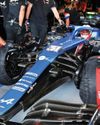
The primary function of any exhaust system is to release the exhaust gases from the engine out into the atmosphere. However, in modern Formula 1 they also have a whole host of other functions, including optimising engine, aerodynamic and turbocharger performance.
The journey of the exhaust gases begins once the fuel and air mixture has combusted during the power stroke of the combustion cycle. After this the piston moves back up the cylinder completing the exhaust stroke, where the exhaust valve opens and the burnt gases are expelled from an area of high pressure in the cylinder to low pressure in the exhaust pipe. At the same time, the inlet valve is also open, allowing fresh charge into the cylinder. This point in the cycle is called ‘valve overlap’.
As the exhaust gases move through the exhaust pipes they create pressure waves and when these pressure waves reach a change in geometry a negative pressure wave is created. The timing of these negative pressure waves can actually help to draw the exhaust gases out of the cylinder more effectively. In turn, this lowers the pressure in the cylinder, which then helps to draw more fresh charge through the inlet valve; helping to increase volumetric efficiency.
Hi-tech plumbing
Once the gases leave the combustion chamber, they travel into a set of primaries, or headers, which are usually of equal length, to ensure that no cylinder is overworking. There is one primary for each cylinder which is connected via a specialised flange to suit the specific geometry of the cylinder head. The three primaries coming from each bank of the engine then join together in a three-to-one primary collector. After which, two secondary pipes then go into the turbo. Depending on the engine manufacturer, the primaries, collector, and secondaries can either be all one-piece and integrated into the turbocharger, or separate pieces.
This story is from the Anatomy of a Racecar edition of Racecar Engineering.
Start your 7-day Magzter GOLD free trial to access thousands of curated premium stories, and 8,500+ magazines and newspapers.
Already a subscriber ? Sign In
This story is from the Anatomy of a Racecar edition of Racecar Engineering.
Start your 7-day Magzter GOLD free trial to access thousands of curated premium stories, and 8,500+ magazines and newspapers.
Already a subscriber? Sign In
Talk the torque
More thoughts on in-wheel motors and their effects on twisting force
Rolling about
An explanation of the limitations of a previous load transfer article, bringing jacking forces into the mix
F1 breaks schedule records
The FIA has confirmed no fewer than 23 races on the 2022 Formula 1 World Championship schedule, the highest number of grands prix ever to be held in a single season, and that has led to criticism from some teams that will be on the road for eight months.

Under pressure
Toyota may have finished first and second at Le Mans this year, but the effort required to overcome a fuel delivery problem and finish with both cars was Herculean
Physics at work
Dutch company, Intrax, offers Racecar Engineering an insight into the technologies it employs to optimise its suspension products
Williams' 2030 ambition
Williams Racing has committed to becoming climate positive by 2030 as part of an all-new sustainability strategy.
Diff'rent strokes
Racecar looks at the different types of mechanical differential, their benefits and limitations
Das Boot
A curious Twitter exchange fired up a unique, hydrogen-powered, cross-country project that will contest the Baja 1000 in November 2022

Air born
Every racecar engineer's dream is a blank sheet of paper design. When Hoonigan and Subaru approached Vermont Sportscars about building the next generation of Gymkhana racer, that's just what the company was given

Remote control
Called variously ‘virtual garages’, ‘mission control’ or ‘race support rooms’ is the future of race engineering sitting in the warm back at HQ?